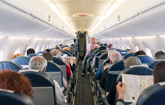Bay Area Airport Committee Recommends More Flights For Oakland, San Jose
Runway Capacity May Limit SFO Growth Trend
OAKLAND, Calif., May 22, 2012 /PRNewswire/ -- A new report by the Regional Airport Planning Committee (RAPC) shows San Francisco International Airport (SFO) continuing to attract new airline passengers while passenger counts at both Oakland International Airport (OAK) and Mineta San Jose International Airport (SJC) have fallen in recent years. RAPC's Regional Aviation Activity Tracking Report reveals that despite a nearly 16 percent increase in passenger volumes at SFO, the total number of passengers using the Bay Area's three major airports fell to 58.4 million in 2011, a 3.6 percent drop from 60.6 million passengers in the pre-recession year of 2007. Looking ahead, RAPC expects a reversal of this trend and forecasts the number of passengers at Bay Area airports to soar to 101.3 million in 2035. In response, the long-range plan recommends:
- encouraging airlines to add more flights at the Oakland and San Jose airports, thus shifting more air passengers to these facilities in the years ahead;
- encouraging airlines to provide more service at the Charles M. Schulz-Sonoma County Airport to accommodate the needs of North Bay air passengers;
- supporting further airline service expansion at airports outside the Bay Area, such as Sacramento, Stockton and Monterey, to make these facilities more attractive to passengers who currently use Bay Area airports;
- implementing key elements of the Federal Aviation Administration's NextGen air traffic system to enable more efficient airspace and runway operations;
- implementing new demand management approaches at SFO to better match airline fleets and schedules with the airport's runway capacity; and
- using high-speed rail to meet a portion of the travel demand among passengers traveling between the Bay Area and other parts of California.
RAPC's forecasts had assumed overall passenger activity at the Bay Area's three major airports would return to pre-recession levels in 2011. But SFO was the only one of the three airports to post higher passenger volumes last year than it did four years earlier.
This growth brings its own set of challenges. Flight delay problems at SFO already are common during poor weather due to the close spacing of the airport's two main landing runways. Because one way for airports to handle more passengers with existing runways is for airlines to use bigger planes that can carry more passengers per flight, a positive trend at SFO is an increase in the average number of passengers per flight to 118.6 last year from 115.6 in 2007. RAPC's long-range forecasts indicate a gradual continuation of this trend, driven by a growing market for long-distance international travel that requires larger wide-body aircraft. However, because SFO is a connecting hub for United Airlines, it will continue to serve large numbers of regional jets and turboprops, which are more economical for feeder service from outlying communities.
"Part of RAPC's long-range strategy," explained Doug Kimsey, planning director for the Metropolitan Transportation Commission (MTC), "is to relieve pressure on SFO's runways by expanding the use of the Oakland and San Jose airports. Both airports have the terminal facilities and runway capacity to accommodate more flights. But since it's the airlines who decide where they want to add service, it's hard to look 20 or 25 years into the future and forecast precisely how many passengers will use each Bay Area airport."
RAPC includes representatives from the three major Bay Area airports, the Association of Bay Area Governments and the Bay Conservation and Development Commission as well as MTC. The complete Regional Aviation Activity Tracking Report can be reviewed online at http://mtc.ca.gov/planning/air_plan/Airport_Tracking_Report.pdf.
MTC is the transportation planning and financing agency for the nine-county San Francisco Bay Area.
SOURCE Metropolitan Transportation Commission
WANT YOUR COMPANY'S NEWS FEATURED ON PRNEWSWIRE.COM?
Newsrooms &
Influencers
Digital Media
Outlets
Journalists
Opted In





Share this article